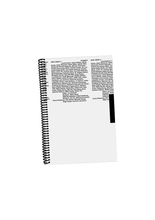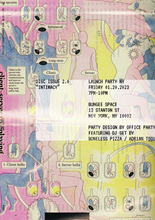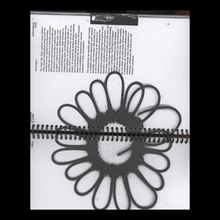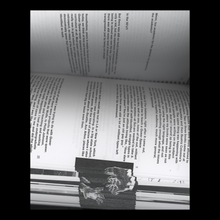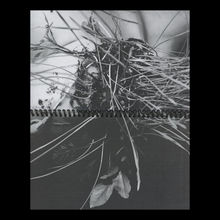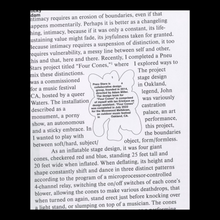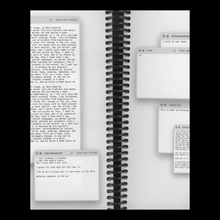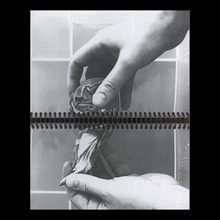Disc Journal Issue 2.0 “intimacy”
Disc Journal
Regular price
$40.00
Sale
Disc Journal is a publication that explores the entanglements between architecture, media, and technology. Each issue has a different theme, form, and designer. Disc is editorially independent and para-institutional.
Edited by Ian Erickson
Designed by Betty Wang
Issue 2.0 “intimacy” features essays, zines, perfumes, hand towels, posters, rope, stickers, cards, temporary tattoos and more by:
Aaron Betsky, Abdul Qutub, Adam Maserow, Adam Miller, Adrian Silva, Alexandra Pereira Edwards, Alfredo Thiermann, Andrew Economos Miller, Andrew Holder, Ani Liu, Austin Wade Smith, Ava Violich Kennedy, Charles Weak, CoCo Tin, Corinne Botz, Courtney Richeson, David Eskenazi, Deborah Garcia, Dr. Regner Ramos, Elizabeth Galvez, Elizabeth Henaff, Elsa MH Mäki, Evan Pavka, f-architecture, Geoff Manaugh, HOME-OFFICE, Henry Weikel, Isabel Strauss, Jaffer Kolb, Jason Campbell, just practice, Kleanthis Kyriakou, Lafayette Cruise, Leah Wulfman, Lukas WinklerPrins, Malcolm Rio, Mamoun Nukumanu Friedrich-Grosvenor, Marianna Gonzalez-Cervantes, Mark Wigley, Materials & Applications, Melanie Hoff, Miles Gertler, Mindy Seu, Nahee Kim, Park Frost, Phillip Denny, Rita Rui Ting Wang, Sonia Sobrino Ralston, VERS Collab, and Wendi Yan
Issue 2.0 of Disc takes up Harraway’s timely concept of “intimacy without proximity” to invite you to consider the importance and complexity of intimacy as a way of stitching together many tender relationships in a time of widespread estrangement. The aphorism is acutely felt, no less relevant now than when it first widely circulated on social media in the early months of 2020’s global shutdown. The design collective CSS helped popularize the expression then, emphasizing the term’s “interwoven tree of influence” from Donna Harraway to Jacob Metcalf to Karen Barad to Dante’s definition of Hell as “proximity without intimacy.”
If Dante is to be believed, our situation is dire: our moment is characterized more by a lack of intimacy than its abundance. Earth resembles Hell. While intimacy’s Latin root, intimare, means “to make familiar,” the ongoing cycle of western capitalist production is understood as a process of making social and material relations unfamiliar. The abstraction of capital has decoupled us from the systems that support us, from the production of a public body, and from the things we make.
Intimacy’s power to re-familiarize and demystify alienated subjects has been recognized by scholars like Ara Wilson, who argues for “infrastructural intimacy,” a framework of acquaintance that we might extend to other systems that are similarly occluded from our perception, from opaque algorithms to impenetrable building codes to buildings themselves. If 2019’s The Last Black Man in San Francisco can be understood as a love story between a man and a house, what other intimate narratives might we tell about architecture? What existing intimacies might deserve to be strengthened? What new kinds of intimacy might deserve to be forged: cross-species solidarities, cybernetic empathies, novel paradigms of maintenance and care?
In architecture, what might it mean for us to upend the discipline’s visual supremacy by embracing other modes of embodied engagement with our built environment: scent, tactility, sound, and other post-Cartesian perceptions of space? What do we make of architecture’s complex relationship to sex as our discipline and its attendant technologies are increasingly entangled with bodily encounters from the bedroom to the metaverse? What might our ongoing efforts to challenge the institutions that surround architecture learn from soft power, which co-opts rather than coerces? What might institutional critique via seduction look like?
The second issue of Disc invites us to get close, cuddle up, and collectively consider the ways intimacy shapes how we live together within our complex ecosystem of bodies, bytes, and buildings.
Disc is committed to centering and amplifying QTBIPOC voices.
391 full color pages
6” x 9”
Bungee Event:









